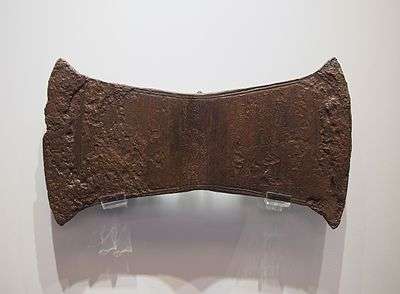Arkalochori Axe
The Arkalochori Axe is a 2nd millennium BC Minoan bronze votive double axe excavated by Spyridon Marinatos in 1934 in the Arkalochori cave on Crete,[1] which is believed to have been used for religious rituals.[2] It is inscribed with fifteen symbols.

It has been suggested that these symbols might be Linear A, although some scholars disagree.[3]
The labrys and the Phaistos Disc are conserved in the Heraklion Archaeological Museum. They share some symbols.
Inscription
Of the fifteen signs, two appear to be unique. The following suggestions for comparison with Linear A and Phaistos Disc glyphs are attributed to Torsten Timm (2004).[4] Reading top to bottom, right to left, the symbols are:
| № | Sign | Comment | Linear A | Phaistos Disc |
| 01 | A 304 |
|||
| 02 | AB28 |
D39 | ||
| 03 | AB01 |
|||
| 04 | D02 | |||
| 05 | ||||
| 06 | AB05 |
|||
| 07 | cf. 04 | D02 | ||
| 08 | AB80 |
|||
| 09 | AB04 |
D35 | ||
| 10 | cf. 04 | D02 | ||
| 11 | AB31 |
D19 | ||
| 12 | cf. 08 | AB80 |
||
| 13 | AB06 |
D23 | ||
| 14 | Root? | |||
| 15 | A338 |
|||
| Wikimedia Commons has media related to Axe of Arkalochori. |
Note that reading top to bottom, right to left after turning the inscription counterclockwise gives a different sequence and numbering of the glyphs. The alternative sequence is suggested to be translatable as a text with a dedicatory offering to Tammuz.[5]
See also
- Phaistos Disc
- Youra Potsherds
- Dispilio tablet
References
- Best, Jan G. P.; Woudhuizen, Fred (31 December 1989). Lost Languages from the Mediterranean. Brill. p. 97. ISBN 978-90-04-08934-1.
- Whittaker, Helène (2005). "Social and Symbolic Aspects of Minoan writing". European Journal of Archaeology. 8 (2): 157–181. doi:10.1177/1461957105058207.
- Price, Glanville (2000). Encyclopedia of the languages of Europe. Wiley-Blackwell. p. 384. ISBN 978-0-631-22039-8.
- Timm, Torsten (2004). "Der Diskos von Phaistos - Anmerkungen zur Deutung und Textstruktur". Indogermanische Forschungen (109): 204–231. (PDF 0.5 Mb)
- Revesz, Peter Z. "A translation of the Arkalochori Axe and the Malia Altar Stone". WSEAS Transactions on Information Science and Applications (Vol. 14, (2017)): 124–133.